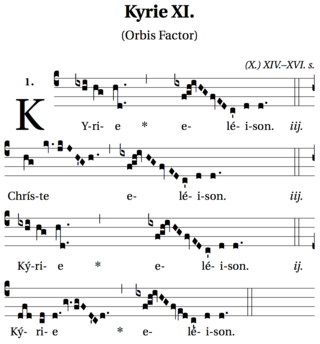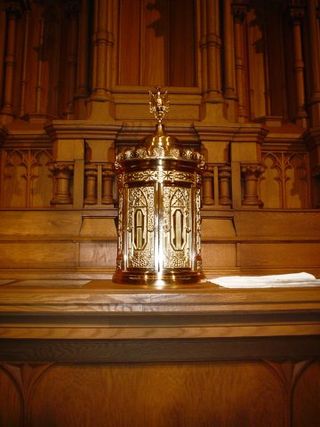Related Research Articles

The Roman Missal is the title of several missals used in the celebration of the Roman Rite. Along with other liturgical books of the Roman Rite, the Roman Missal contains the texts and rubrics for the celebration of the most common liturgy and Mass of the Catholic Church.

Mass is the main Eucharistic liturgical service in many forms of Western Christianity. The term Mass is commonly used in the Catholic Church, Western Rite Orthodoxy, Old Catholicism, and Independent Catholicism. The term is also used in some Lutheran churches, as well as in some Anglican churches, and on rare occasion by other Protestant churches.

The Mass of Paul VI, also known as the Ordinary Form or Novus Ordo, is the most commonly used liturgy in the Catholic Church. It was promulgated by Pope Paul VI in 1969 and its liturgical books were published in 1970; those books were then revised in 1975, they were revised again by Pope John Paul II in 2000, and a third revision was published in 2002.

The Tridentine Mass, also known as the Traditional Latin Mass or the Traditional Rite, is the liturgy in the Roman Missal of the Catholic Church codified in 1570 and published thereafter with amendments up to 1962. Celebrated almost exclusively in Ecclesiastical Latin, it was the most widely used Eucharistic liturgy in the world from its issuance in 1570 until the introduction of the Mass of Paul VI.

Kyrie, a transliteration of Greek Κύριε, vocative case of Κύριος (Kyrios), is a common name of an important prayer of Christian liturgy, also called the Kyrie eleison.

The Anaphora is the most solemn part of the Eucharistic liturgies, such as the Divine Liturgy or the Mass, which serves as a thanksgiving prayer by virtue of which the offerings of bread and wine are consecrated as the body and blood of Christ. This is the usual name for this part of the Liturgy in Greek-speaking Eastern Christianity. In the Eastern Syriac tradition Qudaša is its equivalent. The corresponding part in western Christian liturgy is nowadays most often called the Eucharistic Prayer. The Roman Rite from the 4th century until after Vatican II had a single such prayer, called the Canon of the Mass.

The Roman Rite is the most common ritual family for performing the ecclesiastical services of the Latin Church, the largest of the sui iuris particular churches that comprise the Catholic Church. The Roman Rite governs rites such as the Roman Mass and the Liturgy of the Hours as well as the manner in which sacraments and blessings are performed.
Missale Romanum is the incipit of an apostolic constitution issued by Pope Paul VI on 3 April 1969. It promulgated the new revised version of the Roman Missal.

During the Mass of the Faithful, the second part of the Mass, the elements of bread and wine are considered to have been changed into the veritable Body and Blood of Jesus Christ. The manner in which this occurs is referred to by the term transubstantiation, a theory of St. Thomas Aquinas, in the Roman Catholic Church. Members of the Orthodox, Anglican, and Lutheran communions also believe that Jesus Christ is really and truly present in the bread and wine, but they believe that the way in which this occurs must forever remain a sacred mystery. In many Christian churches some portion of the consecrated elements is set aside and reserved after the reception of Communion and referred to as the reserved sacrament. The reserved sacrament is usually stored in a tabernacle, a locked cabinet made of precious materials and usually located on, above, or near the high altar. In Western Christianity usually only the Host, from Latin: hostia, meaning "victim", is reserved, except where wine might be kept for the sick who cannot consume a host.

Catholic liturgy means the whole complex of official liturgical worship, including all the rites, ceremonies, prayers, and sacraments of the Church, as opposed to private devotions. In this sense the arrangement of all these services in certain set forms is meant. Liturgy encompasses the entire service: prayer, reading and proclamation, singing, gestures, movement and vestments, liturgical colours, symbols and symbolic actions, the administration of sacraments and sacramentals.

The Mass is the central liturgical service of the Eucharist in the Catholic Church, in which bread and wine are consecrated and become the body and blood of Christ. As defined by the Church at the Council of Trent, in the Mass "the same Christ who offered himself once in a bloody manner on the altar of the cross, is present and offered in an unbloody manner". The Church describes the Mass as the "source and summit of the Christian life", and teaches that the Mass is a sacrifice, in which the sacramental bread and wine, through consecration by an ordained priest, become the sacrificial body, blood, soul, and divinity of Christ as the sacrifice on Calvary made truly present once again on the altar. The Catholic Church permits only baptised members in the state of grace to receive Christ in the Eucharist.

In Christianity, concelebration is the presiding of a number of presbyters at the celebration of the Eucharist with either a presbyter or bishop as the principal celebrant and the other presbyters and bishops present in the chancel assisting in the consecration of the Eucharist. The concelebrants assist the principal celebrant by reciting the Words of Consecration together with them, thus effecting the change of the eucharistic elements. They may also recite portions of the Eucharistic Prayer.
Summorum Pontificum is an apostolic letter of Pope Benedict XVI, issued in July 2007. This letter specifies the circumstances in which priests of the Latin Church could celebrate Mass according to what Benedict XVI called the "Missal promulgated by Blessed John XXIII in 1962" and administer most of the sacraments in the form used before the liturgical reforms that followed the Second Vatican Council.

The liturgical books of the Roman Rite are the official books containing the words to be recited and the actions to be performed in the celebration of Catholic liturgy as done in Rome. The Roman Rite of the Latin or Western Church of the Catholic Church is the most widely celebrated of the scores of Catholic liturgical rites. The titles of some of these books contain the adjective "Roman", e.g. the "Roman Missal", to distinguish them from the liturgical books for the other rites of the Church.
The Zaire Use, also called Zairean Rite, officially the Roman Missal for the Dioceses of Zaire, is a Congolese liturgical use of the Roman Rite within the Catholic Church. Approved by the Vatican in 1988, it contains many elements from the Ordinary Form of the Roman Rite, but also incorporates elements from sub-Saharan African culture, particularly Congolese, including a number of inculturated liturgical modifications.

There are seven sacraments of the Catholic Church, which according to Catholic theology were instituted by Jesus Christ and entrusted to the Church. Sacraments are visible rites seen as signs and efficacious channels of the grace of God to all those who receive them with the proper disposition.

The Order of Christian Initiation of Adults (Latin: Ordo initiationis christianae adultorum), or OCIA, is a process developed by the Catholic Church for its catechumenate for prospective converts to the Catholic faith above the age of infant baptism. Candidates are gradually introduced to aspects of Catholic beliefs and practices. The basic process applies to adults and children who have reached catechetical age. Previously, the OCIA was known as the Rite of Christian Initiation of Adults (RCIA). The English name of the process was changed by the United States Conference of Catholic Bishops in 2021 to reflect greater fidelity to the original Latin, although this change has yet to be officially approved by the Dicastery for Divine Worship and the Discipline of the Sacraments.
Responsorial psalmody primarily refers to the placement and use of the Psalm within the readings at a Christian service of the Eucharist. The Psalm chosen in such a context is often called the responsorial psalm. They are found in the liturgies of several Christian denominations, including those of Roman Catholicism, Lutheranism and Anglicanism.

Aperuit illis is an apostolic letter, by Pope Francis, issued "motu proprio" on September 30, 2019, the Feast of Saint Jerome, instituting the annual observance of the 3rd Sunday of Ordinary Time as "Sunday of the Word of God", devoted to the celebration, study and dissemination of the Word of God. The first "Sunday of the Word of God" occurred on January 26, 2020. The Pope said that he wrote the Apostolic Letter in response to requests from around the world to celebrate the Sunday of the Word of God.
Traditionis custodes is an apostolic letter issued motu proprio by Pope Francis, promulgated on 16 July 2021 regarding the continued use of pre-Vatican II rites. It restricts the celebration of the Tridentine Mass of the Roman Rite, sometimes colloquially called the "Latin Mass" or the "Traditional Latin Mass". The apostolic letter was accompanied by an ecclesiastical letter to the Catholic bishops of the world.
References
- ↑ "Eucharistic Prayers for Masses with Children" . Retrieved September 18, 2015.ICEL (May 1, 2014). Eucharistic Prayers for Masses with Children. London: CTS. ISBN 9781860829215.
- ↑ "Directory for Masses with children | Angelus News". 2019-02-06. Retrieved 2020-06-23.
- ↑ USCCB (2013). Lectionary for Masses with Children. Catholic Book Publishing Company.
- ↑ "General Instruction of the Roman Missal". 86. Retrieved September 17, 2015.
{{cite web}}: CS1 maint: location (link)